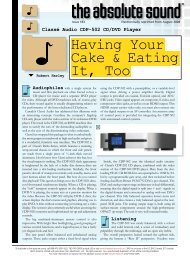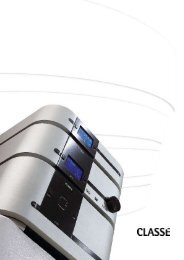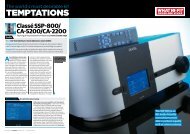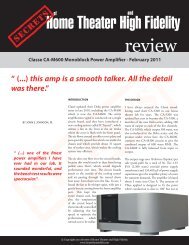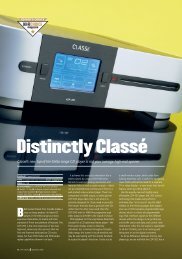Power and poise - Classé Audio
Power and poise - Classé Audio
Power and poise - Classé Audio
You also want an ePaper? Increase the reach of your titles
YUMPU automatically turns print PDFs into web optimized ePapers that Google loves.
REPRINTED FROM may 2007
Classé CP-700 preamplifier <strong>and</strong> CA-M400 monoblock power amplifiers [ Review ]<br />
<strong>Power</strong> <strong>and</strong> <strong>poise</strong><br />
This sophisticated stereo amp system combines impressive muscle with exceptional refinement<br />
PRODUCT Classé CP-700 <strong>and</strong> CA-M400<br />
TYPE Preamplifier <strong>and</strong> monoblock power amplifiers<br />
PRICE (CP-700) £5,450; (CA-M400) £3,950 each<br />
KEY FEATURES (CP-700) Size (WxHxD):<br />
44.5x12.1x41.9cm P Weight: 22.4kg P Inputs: four<br />
single-ended (RCA phono), two balanced (XLR)<br />
P Outputs: one single-ended, one balanced, one tape<br />
P (CA-M400) Size (WxHxD): 44.5x22.2x47cm<br />
P Weight: 37kg P Inputs: one single-ended, one<br />
balanced P Rated power: 400 watts per channel (8 ohms)<br />
CONTACT 01903 221500 q www.classeaudio.com<br />
Classé makes two ranges of audio<br />
electronics: the top-flight Omega series<br />
<strong>and</strong> the more down to earth, but still<br />
aspirational, Delta. This latest preamp <strong>and</strong><br />
monoblock combination represents the top of<br />
the Delta tree.<br />
The distinctive broad radii <strong>and</strong> contrasting<br />
colours of the Delta components are the work<br />
of Morton Warren, a name you may recall from<br />
the time when B&W launched its original curvy<br />
800 series. While this connection could have<br />
been coincidental, the fact that B&W now<br />
owns Classé would suggest otherwise.<br />
or responsive as mechanical alternatives, but<br />
they work well enough once you get the knack.<br />
Among the multitude of options are the<br />
ability to set the name, volume offset <strong>and</strong><br />
balance setting for each input. If you name an<br />
input ‘SSP’, it becomes a unity gain input; in<br />
other words, it bypasses the volume control.<br />
This is useful when integrating a home cinema<br />
system into the hi-fi, but dangerous in the<br />
wrong h<strong>and</strong>s.<br />
You can also adjust the rate that the rotary<br />
control changes volume, but the st<strong>and</strong>ard<br />
speed-sensing setting is logical enough – the<br />
faster the knob is turned the greater the<br />
volume steps. This did catch us out a few times,<br />
though; for instance, when the preamp has<br />
‘gone to sleep’ <strong>and</strong> turned off its display, one<br />
way of awakening it is to turn the knob. This<br />
can sometimes send it to 0.0 <strong>and</strong> be a little<br />
reluctant to go back up to the 40-50 range<br />
where we wanted it.<br />
The CP-700’s back panel features a large<br />
multipin socket, which hooks up to an external<br />
power supply via a usefully long umbilical<br />
cable. This supply houses two boards, one<br />
h<strong>and</strong>ling the conversion of AC to DC <strong>and</strong> the<br />
“This is a very fine example of what can<br />
be achieved with a decent budget <strong>and</strong> some<br />
extra-box thinking.”<br />
The casework is more than just attractive. It is<br />
also designed to isolate the electronics from<br />
vibration. To this end, both steel <strong>and</strong><br />
aluminium are used together <strong>and</strong> large feet<br />
made from a material called Navcom<br />
Limbsaver (developed for target shooting <strong>and</strong><br />
archery) were selected for their ability to offset<br />
any resonance within the supporting surface.<br />
The CP-700 preamplifier sports another<br />
distinguishing feature of the Delta range in its<br />
touchscreen control panel. This is a very fine<br />
example of what can be achieved with a<br />
decent budget <strong>and</strong> some extra-box thinking.<br />
It’s a clever way of addressing the differing<br />
control needs of the various components<br />
within the range, all the while maintaining<br />
consistency of appearance <strong>and</strong> economy of<br />
production. With the DVD players <strong>and</strong><br />
processors, this screen can be used to view<br />
video footage, but with this stereo preamplifier<br />
it brings easy access to a wide selection of<br />
controls. Touch screens are not quite as tactile<br />
other managing the regulation of the supply to<br />
the preamp. Elsewhere on the back panel, you<br />
will find balanced <strong>and</strong> single-ended inputs <strong>and</strong><br />
outputs, alongside an RS-232 control port,<br />
in/outputs for IR comm<strong>and</strong>s <strong>and</strong> the DC<br />
triggers that are popular in the US. Last but<br />
not least, there’s the remote h<strong>and</strong>set – an<br />
attractive <strong>and</strong> intuitive piece of aluminium <strong>and</strong><br />
rubber that lights up blue at your touch. Nice.<br />
The CA-M400 monoblock is a hefty lump of<br />
a power amplifier that is specified to double its<br />
400-watts-into-eight-ohms output into a<br />
halving of load <strong>and</strong> weighs in at a respectable<br />
37kg. While it has both balanced <strong>and</strong> singleended<br />
inputs, you need to switch between the<br />
two on the front panel. This is something end<br />
users won’t do as often as reviewers <strong>and</strong> thus<br />
of limited entertainment value, but it looks<br />
good. Other connections are for triggers,<br />
firmware updates <strong>and</strong> Classé’s bus system.<br />
Inside the case, Classé has deployed three<br />
types of transistor in order to create a balance<br />
of qualities that it argues a single variety, with<br />
its inherent strengths <strong>and</strong> weaknesses, cannot<br />
duplicate. So there are J-FETs in the input<br />
stage, MOSFETS in the driver stage <strong>and</strong> bipolar<br />
output devices.<br />
SOUND QUALITY<br />
With this much power on tap, one thing you are<br />
guaranteed is an assured <strong>and</strong> relaxed sound;<br />
the MA-400s are unlikely to break sweat when<br />
driving the majority of loudspeakers. But it was<br />
encouraging to find this pairing also has an<br />
impressively light touch for its class.<br />
They are not the most dynamic-sounding<br />
amps on the block. Some of the competition<br />
have a more obviously exciting <strong>and</strong> energetic<br />
presentation, but those competitors don’t have<br />
the same headroom <strong>and</strong> can’t produce high<br />
levels with the degree of ease on offer here. On<br />
their own terms, the CA-M400s have an<br />
uncanny ability to peel apart the elements in a<br />
recording to reveal precisely what each one P<br />
REPRINTED FROM may 2007
[ Review ] Classé CP-700 preamplifier <strong>and</strong> CA-M400 monoblock power amplifiers<br />
Q&A<br />
We discussed amplifiers with<br />
Dave Nauber, vice president of<br />
br<strong>and</strong> development at Classé<br />
HFC What effect does vibration<br />
have on amplifier electronics?<br />
DN The reason we pay attention<br />
to the chassis is because microphonic effects can<br />
degrade the performance of some circuitry. In other<br />
words, as PC boards <strong>and</strong> components vibrate, there<br />
are slight relative movements among the parts,<br />
which generate small signals, which are amplified<br />
<strong>and</strong> become part of the music signal. The worst<br />
offenders are vacuum tubes. In solid-state<br />
electronics, <strong>and</strong> especially with surface-mount<br />
components, the effect is dramatically reduced, but<br />
not eliminated. This is why people pay so much<br />
attention to equipment st<strong>and</strong>s.<br />
You use three types of transistor in the<br />
CA-M400’s signal path. Why?<br />
The choice of multiple transistor types is made to<br />
capitalize on their relative strengths <strong>and</strong> conceal<br />
their weaknesses. A J-FET input stage, for example,<br />
is easy to drive, relatively insensitive to interconnect<br />
cable variances, very low distortion <strong>and</strong> very low<br />
noise. The J-FET is an excellent voltage gain device.<br />
It cannot, however, deliver the current necessary to<br />
drive a proper output stage, let alone a<br />
loudspeaker. So MOSFET transistors are used after<br />
J-FETs because we can design the input stage to<br />
easily drive the MOSFET driver stage, which<br />
provides some of both voltage <strong>and</strong> current gain.<br />
The MOSFETs can in turn supply enough current to<br />
easily drive the bipolar output stage, which is<br />
widely recognized as being ideal for linearity <strong>and</strong><br />
high current.<br />
The Delta preamp topology appears to be<br />
completely different to your range-topping<br />
Omega preamp. Why?<br />
The Omega was conceived as a cost-no-object<br />
reference preamplifier, yet it is several years older<br />
than the CP-700. It uses a resistor ladder network<br />
for switching volume <strong>and</strong> does not offer the<br />
isolation between single-ended <strong>and</strong> balanced<br />
outputs that the CP-700 does. On the other h<strong>and</strong>,<br />
the MkIII power supply is more extreme <strong>and</strong> the<br />
chassis more<br />
costly. I think<br />
of the Omega<br />
as a bit more<br />
brute force,<br />
‘throw money<br />
at it until you<br />
get the<br />
performance’<br />
<strong>and</strong> the CP-700<br />
as more<br />
sophisticated<br />
<strong>and</strong> clever.<br />
People have<br />
different opinions<br />
about which is<br />
better, but for the<br />
money the CP-700<br />
is a real bargain.<br />
Detail – CP-700<br />
Four-layer circuit boards<br />
for optimum signal<br />
routing<br />
Space for optional phono<br />
module (left channel)<br />
+/- supply voltage<br />
regulation for left channel<br />
<strong>Power</strong> supply for control<br />
<strong>and</strong> monitoring circuits<br />
Detail – CA-M400<br />
Separate secondary<br />
power supply for<br />
control <strong>and</strong><br />
monitoring circuits<br />
Third independent power<br />
supply for monitoring/<br />
sensor circuits<br />
Q contributes, without making the sound seem<br />
analytical. In combination with the preamp, they<br />
present the finest nuances in such an effortless<br />
fashion that your attention is never distracted<br />
from the music <strong>and</strong> its underlying message.<br />
The Classé combo doesn’t make a big thing<br />
about grip, speed or slam – it goes about its<br />
business in a remarkably neutral <strong>and</strong><br />
unprepossessing way. This means the music<br />
has a better chance than usual of doing<br />
precisely what the artist, producer <strong>and</strong><br />
mastering engineer had in mind. It also means<br />
that differences between musicians,<br />
instruments <strong>and</strong> recordings are very clear.<br />
The smoothness on offer can give the<br />
impression that clarity is not as great as it<br />
might be, yet when you turn up the wick the<br />
presentation remains precisely the same. There<br />
is no sense of edginess or strain <strong>and</strong> as a result,<br />
high level listening is far more<br />
comfortable than usual. In<br />
this respect, these amps reflect<br />
the character of B&W’s 800<br />
Series speakers, which like as<br />
not were among the arsenal of<br />
transducers used by Classé’s<br />
engineers. They are seemingly<br />
a little polite... <strong>and</strong> then the<br />
fun really starts.<br />
Combining the delicacy of<br />
small amps with the power <strong>and</strong><br />
control of the big boys, Classé’s<br />
titanic trio covers all the bases.<br />
Sure, it’s expensive, but it’s good<br />
enough to compete with the best<br />
amp systems money can buy. HFC<br />
Jason Kennedy<br />
VERDICT –<br />
CP-700 PREAMPLIFIER<br />
SOUND >> 95%<br />
FEATURES >> 96%<br />
BUILD >> 96%<br />
VALUE >> 88%<br />
VERDICT – CA-M400 MONOBLOCK<br />
SOUND >> 93%<br />
FEATURES >> 90%<br />
BUILD >> 96%<br />
VALUE >> 86%<br />
Single-ended<br />
output stage<br />
Left <strong>and</strong> right<br />
channels divided<br />
along centre line<br />
Non-inverting <strong>and</strong><br />
inverting circuits for<br />
balanced output<br />
Each ‘half’ of the<br />
balanced signal is a<br />
200-watt amplifier<br />
module<br />
Surge resistor provides<br />
‘soft-start’ feature on<br />
power up<br />
Large 1.35kVA toroidal<br />
transformer<br />
CONCLUSION<br />
Beautifully built, supremely<br />
flexible preamp is revealing<br />
<strong>and</strong> coherent. We’ve used it as<br />
a reference for months <strong>and</strong><br />
don’t want it to go!<br />
>><br />
CONCLUSION<br />
A behemoth of a monoblock.<br />
If you want control without<br />
the character that often goes<br />
with it, this is a resolute <strong>and</strong><br />
unflappable powerhouse.<br />
>><br />
92%<br />
90%<br />
REPRINTED FROM may 2007






